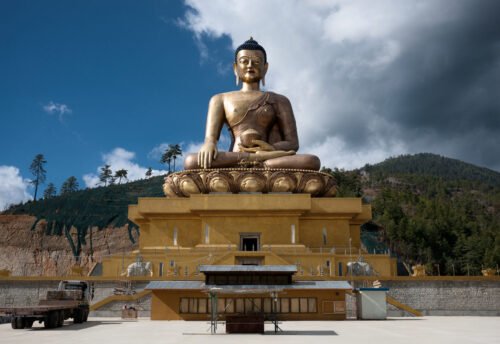
- May 17, 2022
- idruksolution
- 0 Comments
- 151 Views
- 0 Likes
- Bhutan Blog
Bhutan
As the plane veers through a gap in the mountains, minutes before landing, a hidden valley spreads at your feet, framed by pristine forests and snow-capped peaks. At the heart of the Himalaya, Paro appears like a dream, a sprinkling of traditional houses with beautifully carved eaves and frames and auspicious signs painted on the walls. Buddhist flags flutter all around, incense drifts along the streets and nearly everyone wears the iconic national dress. Tucked between India and Tibet, Bhutan is highly traditional yet the country is moving forward: new democracy, new technologies, free education, free healthcare, economic growth and a ten-fold increase in tourism, hailing the campaign ‘Visit Bhutan 2015’. The modern world is welcome, as long as it does not damage the unique cultural traditions which are the soul of the country. It’s the best of both worlds and for the Bhutanese, the secret of the ‘gross national happiness’ promised by the King and ranked above gross national income.
Even with its international airport, Paro is no exception, a sleepy little place where men practise archery, the national sport, and two stunning landmarks symbolise the spirit of the land. Down by the river is the dzong, a fortified monastery with thick whitewashed walls accessed by a covered bridge. Dzongs are found right across Bhutan, the seat of civic administration and the monks’ body, guarding strategic points on river banks or up on lonely hillocks. Inside, temples glow with gilded statues and bright murals while in Paro, the watchtower turned museum houses the world’s most precious stamp collection.
A short drive up valley, Taktsang defies imagination, its shrines and temples clinging to a vertiginous ledge some 800 metres above the paddies. They call it the Tiger’s Lair for according to legend, this is where a guru flying on a tigress came to land to bring Buddhism and chase away demons. It’s the most sacred place in Bhutan and pictured on every postcard and guide book.
Thimphu, the capital, is roughly an hour away, too close to the mountains to accommodate an airport, but with enough space for upmarket hotels, a golf course and a dzong where in 2008, a new king was crowned among great festivities, barely noticed by the outside world.
Small as it is, Thimphu has a fair range of shops, including a National Handicraft Emporium where you can buy the finest kira -the wrap-around ‘dress’ worn by women- or a gho, a knee-length gown worn by men, in a superb range of silk, brocade and handwoven fabric, purely traditional or sporting the latest designer touches. Most regions specialise in crafts based on their own raw material, wood, clay and so on, and items surplus to local needs are sold in Thimphu. From wooden bowls to bamboo ware, from filigree silver to hand-made paper, Buddhist paintings or fabulous textiles, quality is assured as for the Bhutanese, creating beautiful things is an act of worship, a thanksgiving for the gifts of the natural world.
Skills are handed down from one generation to the next but the most promising artists can perfect their craft in a National Institute, either in Trashiyangtse in the East or in Thimphu in the West. These cover the 13 arts and crafts defined in the 17th century by the Shabdrung, the highly-respected leader who unified the country. Prices reflect quality and attempts to bargain would be a lack of appreciation.



Leave a Comment